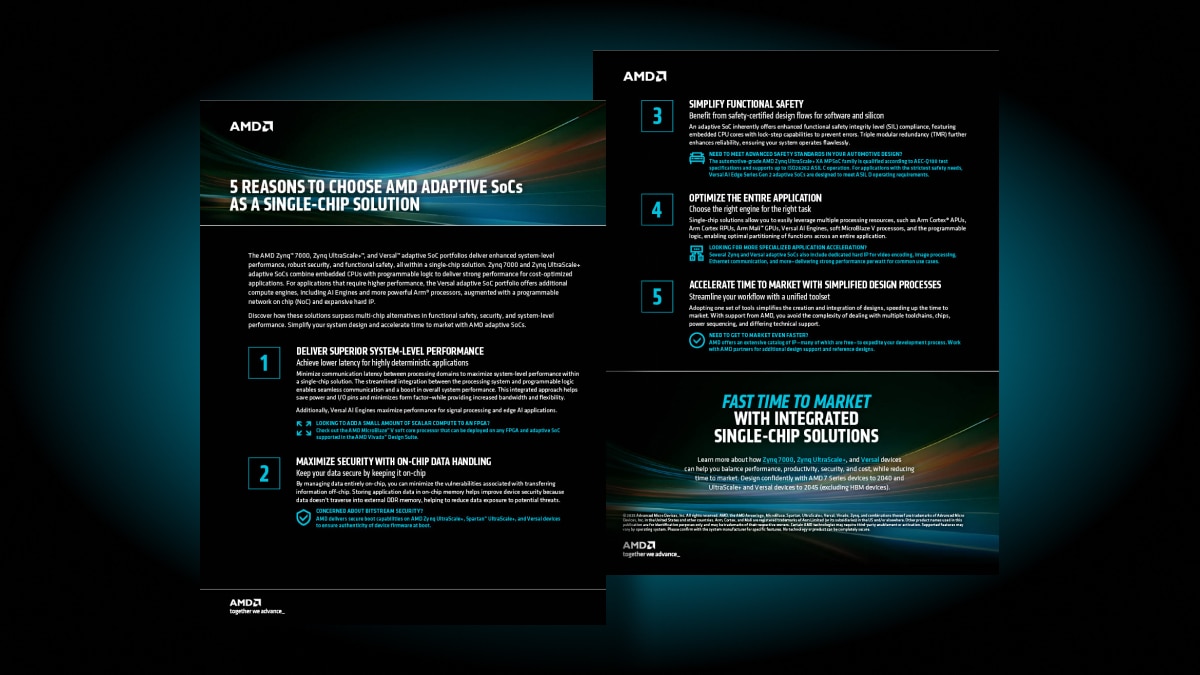Cost-Efficient Solutions Start with Innovative Silicon and Superior Tools
Greater value. Faster time to market. Lower total solution cost.
Total solution cost involves more than just silicon. To truly cost-optimize FPGA designs, you need to consider fabric efficiency, packaging characteristics, design tool costs and usability, IP licensing, development effort, and more.
AMD Cost-Optimized Portfolio devices offer state-of-the-art silicon architecture, optimized to deliver performance and power savings.1 And with a proven path to design success, the AMD Vivado™ Design Suite enables a faster time to market—and to revenue. Simplify your design with a single vendor and reduce the total solution cost.2
How AMD Does it Better: System Integration
Secure. Certify. Integrate. Get to market faster.
Secure Systems Start with Secure Boot
Secure boot is the foundation of a secure system, ensuring authenticity of the code running on your device and safeguarding your IP. AMD Spartan™ UltraScale+™ FPGAs offer state-of-the-art security features including the latest CNSA 2.0 Post Quantum Cryptography (PQC) compliance and FPGA secure boot.
Secure your system with CNSA 2.0 PQC-compliant secure boot and multi-level protection:
- RSA-2048
- NIST-certified AES-GCM post-quantum cryptography
- Physical Unclonable Function (PUF) and True Random Number Generator (TRNG)
- Anti-tamper capabilities
Learn how AMD offers leadership in state-of-the-art FPGA & SoC security solutions.


Fast Track Functional Safety Certification
Accelerate market entry with TUV SUD certified safety design flows for silicon and software. AMD provides a comprehensive TUV SUD certified design flow solution for our customers to simplify and accelerate certifications across end markets.
Simplify Your Design Through SoC Integration
A single-chip solution simplifies design, integrating functions from multiple devices and boosting performance. With AMD adaptive SoCs, you can:
- Improve overall system performance and reduce latency with an integrated SoC compared to stand-alone FPGA solutions
- Optimize your application by choosing the right compute engine for the task – Integrated Arm® Cortex® processors, Arm Mali™ GPUs, video encoding, programmable logic, and more
- Reduce attack surface and help improve security with a single-chip solution, decreasing overall system vulnerability

Learn the 5 reasons to choose AMD adaptive SoCs as a single-chip solution.
How AMD Does it Better: Design Tools
Why settle when you can choose a scale above the rest?
Save valuable time. Eliminate unnecessary iterations and avoid downloading additional tools. The Vivado Design Suite is a single streamlined development tool for AMD cost-optimized FPGAs. It is fully integrated across the design flow, including all capabilities needed to go from RTL design to implementation and debug.

Superior Timing Closure3
Experience out-of-the-box success without having to fight timing closure. Design efficiently while maximizing productivity with the Vivado Design Suite.

Unified Flow for Fewer Iterations
The Vivado Design Suite provides a fully integrated solution from simulation to debug, eliminating the need for costly third-party tools and reducing time to market.

Developer-Driven, Feature-Rich
Vivado Design Suite offers a robust, free IP catalog of more than 500 functions and IP for a wide range of applications.
How AMD Does it Better: Silicon
Innovative architecture for smaller, cooler, cost-optimized designs.
Do more with Spartan UltraScale+ FPGAs. Cutting edge fabric architecture, top-of-the-line peripherals, and superior thermal packaging4 provide industry-leading performance5 for your cost-sensitive applications. Find the device that fits your needs today and for the future.

More Efficient Designs
40% better average utilization with LUT6 vs. competing LUT4 architecture6 because efficient designs start with efficient architecture!

More Hertz
1.8X higher FMAX on average vs. the competition using the same 16 nm process node at the highest speed grades.5

Fewer Watts
Up to 46% lower total power consumption with the Spartan UltraScale+ FPGA's LUT6 architecture, and advanced packaging for high-performance designs vs. the competition’s LUT4 architecture.1
Adaptable Solutions for Cost-Sensitive Applications
AMD offers a broad portfolio of adaptable solutions for cost-sensitive applications. AMD UltraScale+ and 7 Series FPGAs & adaptive SoCs are based on LUT6 architecture, designed to maximize performance while remaining cost-optimized for the price-sensitive customer.
AMD Spartan UltraScale+ FPGA
- Industry’s highest I/O-to-logic-cell ratio in FPGAs built on 28 nm and smaller process technology7
- Up to 30% lower total power consumption vs. the previous generation8
AMD Artix™ UltraScale+ FPGA
- High aggregate transceiver bandwidth for emerging protocols in networking, video, and vision
- Exceptional fixed- and floating-point DSP compute for image and video processing, real-time control, and AI inference
AMD Zynq™ UltraScale+ MPSoC
- Integrates the Arm processor system and UltraScale™ programmable logic architecture in a single device
- Ultra-compact packages with better thermal dissipation for high compute density4
Resources
Get Started with AMD
Resources
AMD FPGA Advantages over Competing Legacy LUT4 Architectures
Maximizing Design Success with AMD Vivado Design Suite

Contact
Get started with the AMD Cost-Optimized Portfolio.
Join the Lounge
A full design suite for benchmarking is available. See for yourself.
Footnotes
The information contained herein is for informational purposes only and is subject to change without notice. No technology or product can be completely secure. GD-122.
- Based on AMD testing in July 2024, performed in AMD Power Estimation Tools (XPE_2019_1_2 for 28 nm and PDM_2024.1 for 16 nm), and Lattice Radiant Power Estimation Tool 2024.1, to measure the power consumption of the AMD Spartan UltraScale+ SU35P, SU50P, and SU100P FPGAs versus Lattice MachXO5-NX-25, CertusPro-NX50, and MachXO5-NX-100T FPGAs at HP speed grade. Total Power results include fabric power and HDIO only. Stated results assume a normalized max ambient temperature of 100°C and a 40% utilization advantage for LUT6, when selecting competitive devices for comparison. Results are subject to change when products are released in market and will vary based on architecture, package size, speed grade, device, design, configuration, and other factors. (SUS-014)
- The AMD Cost-Optimized Portfolio (“COP”) is designed to offer a ‘lower cost solution’, based on AMD internal assumptions, estimates, and best approximations. This claim is representative of the AMD COP, for informational purposes only. AMD recommends customers base purchase decisions on actual testing. See here for additional information. (COP-004)
- Based on AMD place-and-route testing in September 2024, using 26 open-core designs compiled with AMD Vivado 2024.1 and Lattice Radiant Software 2024.1 in default mode, with the AMD Artix UltraScale+ AU10P device versus Lattice Mach LFMXO5 device @ 150 MHz FMAX target; and AMD Kintex UltraScale+ KU5P device versus Lattice Avant E70 device @ 200 MHz FMAX target. P&R performance will vary based on device, design, configuration, and other factors. (VIV-011)
- Based on July 2024 AMD analysis of published data sheets using standard JESD51 definition for θJa versus equivalent Lattice packages. Stated results are provisional and will vary based on architecture, package size, speed grade, device, design, configuration, and other factors. (COP-002)
- Based on AMD analysis in July 2024, calculating FMAX ratios averaged over 30 open-core designs for (16 nm) AMD Artix UltraScale+ AU7P FPGA, compared to the (16 nm) Lattice Avant E70 FPGA, at the respective highest speed grades. Results will vary based on architecture, device, speed grade, package size, design, configuration, and other factors. (AUS-010)
- Based on AMD testing in July 2024, measuring the utilization scores of the LUT6 architecture-based AMD Artix 7 A100T (28 nm) and Artix UltraScale+ AU7P (16 nm) versus the LUT4 architecture-based Lattice Nexus MachXO5 25 (28 nm) and Lattice Avant E70 (16 nm) devices, measured on AMD Vivado 2024.1 and Lattice Radiant 2024.1, respectively, at various speed grades, averaged over 30 open-core designs. Results will vary based on architecture, device, speed grade, package size, design, configuration, and other factors. (COP-001)
- Highest I/O per logic cell is based on an AMD internal analysis of the product data sheet for AMD Spartan UltraScale+ SU10P FPGA and the published data sheets for the comparable competitive FPGAs with a 28 nm and lower node-size, from Efinix, Intel, Lattice, and Microchip. Cost reduction per I/O is based on AMD list prices for the AMD Spartan UltraScale+ SU10P versus Spartan 7 7550 FPGA, as of February 2024, for designs requiring at least 200 GPIO. (SUS-011)
- Projection is based on AMD labs internal analysis in January 2024, using total power calculation (static plus dynamic power) based on the difference in logic cell count of an AMD Artix UltraScale+ AU7P FPGA, to estimate the power of a 16 nm AMD Spartan UltraScale+ SU35P FPGA versus a 28 nm AMD Artix 7 7A35T FPGA, using Xilinx Power Estimator (XPE) tool version 2023.1.2. Total power estimates and projections will vary when products are released in market and based on design, configuration, usage, and other factors. (SUS-003)
- Based on AMD testing in July 2024, performed in AMD Power Estimation Tools (XPE_2019_1_2 for 28 nm and PDM_2024.1 for 16 nm), and Lattice Radiant Power Estimation Tool 2024.1, to measure the power consumption of the AMD Spartan UltraScale+ SU35P, SU50P, and SU100P FPGAs versus Lattice MachXO5-NX-25, CertusPro-NX50, and MachXO5-NX-100T FPGAs at HP speed grade. Total Power results include fabric power and HDIO only. Stated results assume a normalized max ambient temperature of 100°C and a 40% utilization advantage for LUT6, when selecting competitive devices for comparison. Results are subject to change when products are released in market and will vary based on architecture, package size, speed grade, device, design, configuration, and other factors. (SUS-014)
- The AMD Cost-Optimized Portfolio (“COP”) is designed to offer a ‘lower cost solution’, based on AMD internal assumptions, estimates, and best approximations. This claim is representative of the AMD COP, for informational purposes only. AMD recommends customers base purchase decisions on actual testing. See here for additional information. (COP-004)
- Based on AMD place-and-route testing in September 2024, using 26 open-core designs compiled with AMD Vivado 2024.1 and Lattice Radiant Software 2024.1 in default mode, with the AMD Artix UltraScale+ AU10P device versus Lattice Mach LFMXO5 device @ 150 MHz FMAX target; and AMD Kintex UltraScale+ KU5P device versus Lattice Avant E70 device @ 200 MHz FMAX target. P&R performance will vary based on device, design, configuration, and other factors. (VIV-011)
- Based on July 2024 AMD analysis of published data sheets using standard JESD51 definition for θJa versus equivalent Lattice packages. Stated results are provisional and will vary based on architecture, package size, speed grade, device, design, configuration, and other factors. (COP-002)
- Based on AMD analysis in July 2024, calculating FMAX ratios averaged over 30 open-core designs for (16 nm) AMD Artix UltraScale+ AU7P FPGA, compared to the (16 nm) Lattice Avant E70 FPGA, at the respective highest speed grades. Results will vary based on architecture, device, speed grade, package size, design, configuration, and other factors. (AUS-010)
- Based on AMD testing in July 2024, measuring the utilization scores of the LUT6 architecture-based AMD Artix 7 A100T (28 nm) and Artix UltraScale+ AU7P (16 nm) versus the LUT4 architecture-based Lattice Nexus MachXO5 25 (28 nm) and Lattice Avant E70 (16 nm) devices, measured on AMD Vivado 2024.1 and Lattice Radiant 2024.1, respectively, at various speed grades, averaged over 30 open-core designs. Results will vary based on architecture, device, speed grade, package size, design, configuration, and other factors. (COP-001)
- Highest I/O per logic cell is based on an AMD internal analysis of the product data sheet for AMD Spartan UltraScale+ SU10P FPGA and the published data sheets for the comparable competitive FPGAs with a 28 nm and lower node-size, from Efinix, Intel, Lattice, and Microchip. Cost reduction per I/O is based on AMD list prices for the AMD Spartan UltraScale+ SU10P versus Spartan 7 7550 FPGA, as of February 2024, for designs requiring at least 200 GPIO. (SUS-011)
- Projection is based on AMD labs internal analysis in January 2024, using total power calculation (static plus dynamic power) based on the difference in logic cell count of an AMD Artix UltraScale+ AU7P FPGA, to estimate the power of a 16 nm AMD Spartan UltraScale+ SU35P FPGA versus a 28 nm AMD Artix 7 7A35T FPGA, using Xilinx Power Estimator (XPE) tool version 2023.1.2. Total power estimates and projections will vary when products are released in market and based on design, configuration, usage, and other factors. (SUS-003)
